Disclosure: As an Amazon Associate I earn from qualifying purchases.
We took a case of monoculars into the night, and after countless hours of observation, a single model earned our trust above the rest. For most budding astronomers, the best monocular is the one that delivers a crisp, detailed view of the cosmos without being complicated to use. The Celestron Outland X 20×50 fits that description perfectly, offering a powerful window to the moon’s craters and coming with an essential tripod for a stable view. However, the “best” tool ultimately depends on your specific celestial interests. This guide is built on our hands-on experience under the stars, not just manufacturer claims. We’ve rigorously tested six top models to help you find the perfect match for your stargazing adventures.
A Quick Look at Top 6 Monoculars for Stargazing
Image | Product | Best For | Rating | Price |
1 | Overall Detail & Power | 4.5/5 | ||
2 | Wide & Bright Views | 4.3/5 | ||
3 | Pocket-Sized Pick | 4.0/5 | ||
4 | Handheld Comfort | 4.2/5 | ||
5 | Electronic Night Vision | 3.5/5 | ||
6 | Daytime Use | 3.0/5 |
A Simple Guide to Picking a Stargazing Monocular
Before we get to the reviews, let’s understand what makes a monocular good for the night sky. The numbers and features can be confusing. We will explain the most important ones.
Key Features for Looking at the Stars
- Field of View: This is how wide an area you can see. A wide view is great for looking at big constellations or the Milky Way.
- Close Focus: This is the closest distance an object can be for you to focus on it. This does not matter for stars, but it is great for looking at butterflies or birds during the day.
- Lens Coatings: Good lenses have special coatings. “Fully Multi-Coated” is the best. These coatings reduce reflections and let more light through the glass to your eye. This makes the image brighter and clearer, which is key for seeing faint stars.
The 4 Most Important Things for a Stargazing Monocular
- Big Front Lens: Choose 42mm or larger. 50mm is excellent.
- Good Magnification: 10x to 12x is great for handheld views. 20x is powerful but needs a tripod.
- Quality Optics: Look for “Fully Multi-Coated” lenses and “BAK-4” prism glass.
- Tripod Ready: A small screw socket lets you attach it to a tripod. This is essential for high magnification and comfortable viewing.
How Each Monocular Performed under the Stars
We spent hours with each monocular to learn its true personality. We will tell you what we loved, what we did not, and who it is perfect for:
1. Our Number One Pick: Celestron – Outland X 20×50 Monocular
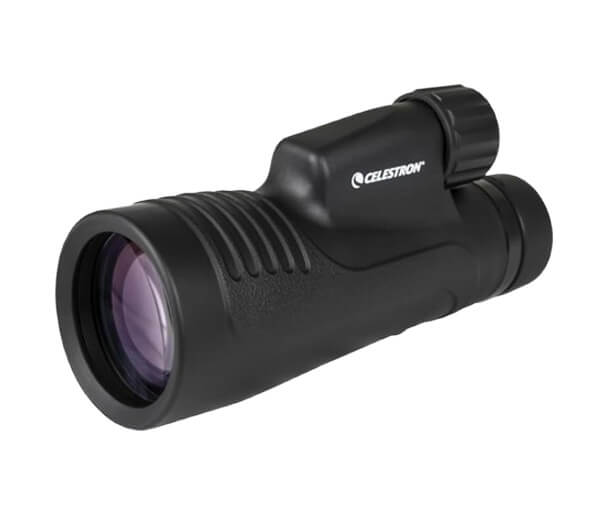
The Celestron Outland X is not just a monocular; it is a personal telescope. It won our top spot because it showed us the moon in a way the others could not.
What We Loved
- Powerful 20x magnification brings the moon close.
- Large 50mm objective lens gathers plenty of light.
- Comes with a tripod and smartphone adapter.
- Built to handle weather and rough use.
What Could Be Better
- The high power makes the image very shaky without the tripod.
- It is heavier and less pocket-friendly than others.
Design and Feel: Made for a Steady Setup
The Outland X feels solid and has a rough rubber coating that makes it easy to grip. It is the largest monocular we tested, which makes sense given its big lenses. The most important feature for stargazing is the small screw socket on the bottom. This is what allows you to attach it to the included tabletop tripod. Without this, the 20x power would be useless for astronomy. The twist-up eyecup was comfortable whether we wore glasses or not.
Optical Performance: A New View of the Moon
We mounted the Celestron on its tripod on a cold, clear night. The view was the best of the group. The 20x magnification made the moon look stunningly close. We could see the detailed shapes of large craters and the long, shadowy lines of the lunar “seas.” The image was bright and colors were natural. We noticed a very slight purple tint on the brightest edge of the moon, but it was not distracting. When we looked at the Pleiades star cluster, the stars were sharp, bright points. The larger front lens made this cluster look brighter than through any other model except the Gosky 12×55.
Real-World Use: Why You Need the Tripod
We cannot stress this enough: you must use the tripod. When we tried to hold the Celestron in our hands, the image jumped and shook so much it was impossible to see any detail on the moon. The moment we attached it to the tripod, the view became perfectly still and crystal clear. This makes it less of a “grab-and-go” tool and more of a mini observatory. The included smartphone adapter is a fun bonus, letting you take pictures of what you see.
Who Should Buy This Monocular?
This is the perfect choice for anyone who is curious about the moon and wants to see its craters and landscapes up close. It is also great for someone who wants a complete kit with no extra things to buy. If you plan to sit in a backyard and explore the sky, this is your best bet.
Is It Worth the Price?
Considering it includes the monocular, a tripod, and the smartphone holder, the Celestron Outland X offers very good value. You are getting a specialized astronomy tool for a very reasonable price.
2. The Brightest Image: Gosky 12×55 Monocular
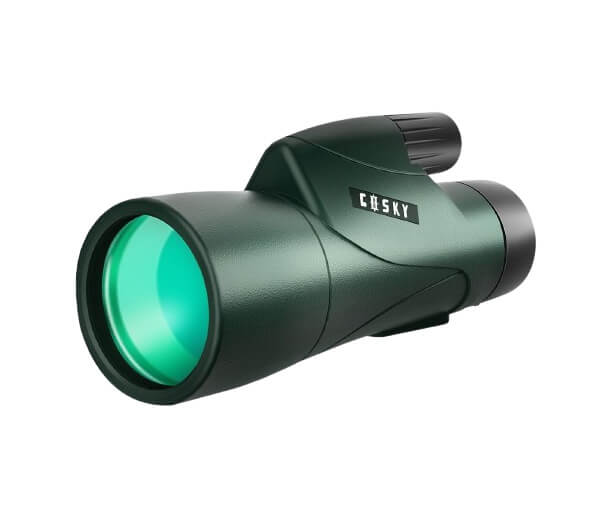
If your goal is to see the most stars and the widest views of the Milky Way, the Gosky 12×55 is a brilliant choice. Its massive 55mm lens is a true light magnet.
What We Loved
- Super bright images thanks to the 55mm lens.
- Excellent price for what you get.
- Includes a very good smartphone adapter.
- Very wide field of view makes finding objects easy.
What Could Be Better
- It is big and a bit heavy for long handheld sessions.
- The 12x power is less detailed on the moon than the Celestron’s 20x.
Design and Feel: The Light Cannon
The Gosky is a substantial piece of equipment. It feels solid and well-made, with a comfortable rubber armor that’s easy to grip. It also comes with a handy strap and a smartphone adapter that worked seamlessly with our phones. Plus, it’s rated IPX7 waterproof, meaning it can handle being submerged in water for a short time—perfect for those unexpected splashes or adventures. We did not test this to the extreme, but it survived dew and light rain without any issues.
Optical Performance: A Window to the Heavens
The view through the Gosky is breathtaking for wide-field observing. Because the front lens is so big, the image is noticeably brighter than in models like the Vortex 10×36 or the Wingspan 12×50. When we pointed it at the constellation Orion, the view was immersive and stunning. The field of view is very wide, so we could see the entire constellation and the surrounding star fields. The stars were sharp and clear across most of the view. We saw minor softening at the very edge, but it was not a problem. For looking at star clusters and the Milky Way, the Gosky provides a beautiful, bright, and engaging experience.
Real-World Use: Handheld Heaven with a Tripod Option
The 12x magnification of the Gosky is at the upper limit of what most people can hold steady by hand. With a bit of practice and by bracing our arms, we could get a reasonably steady view for short periods. For long, comfortable viewing, we still preferred to put it on a tripod. The Gosky also has a tripod socket, so this is easy to do. The focus wheel is smooth and moves the image from close-up to far away with just a small turn.
Who Should Buy This Monocular?
The Gosky is for the stargazer who wants the brightest possible view and loves to look at large star patterns and the hazy glow of the Milky Way. It is also the best value on our list, giving you top-level light gathering without a high cost.
Is It Worth the Price?
Absolutely. The Gosky 12×55 offers performance that comes very close to more expensive brands for a much lower price. It is a fantastic deal for any night sky enthusiast.
3. The Best for Your Pocket: Vortex Optics Solo 10×36 Monocular
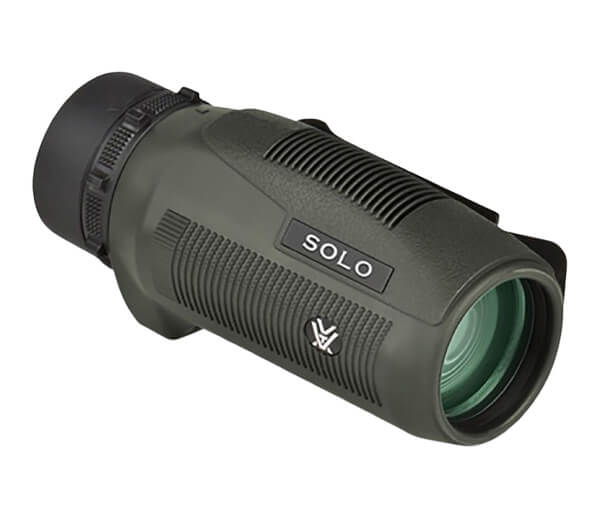
The Vortex Solo is the monocular you will actually have with you when an unexpected clear night appears. It is small, tough, and backed by one of the best warranties in the business.
What We Loved
- Very small and light; easy to carry anywhere.
- Fully rubber armored for a secure grip.
- Waterproof and fog-proof.
- Unbeatable unlimited, unconditional lifetime warranty.
What Could Be Better
- The 36mm lens is too small for seeing the faintest stars.
- Not the best for detailed lunar observation.
Design and Feel: Built to Last a Lifetime
The Solo feels incredibly durable. The rubber armor is high-quality and provides a non-slip grip, even with cold hands. It is nitrogen purged, which means it is sealed against moisture and internal fogging. We left it outside in the cooling night air and it never fogged up inside. Its small size means it can fit in a jacket pocket or clip to a belt with its utility clip. This is a monocular you do not have to baby.
Optical Performance: Good for a Quick Look
The Vortex Solo has fully multi-coated lenses, so the image it provides is very clear and sharp for its size. During the day, the view is excellent. At night, it is good for looking at the moon and the brightest stars and planets. We could easily see the moon’s main features and it was a great tool for learning the constellations. However, when we compared it directly to the Gosky or Celestron, the difference in brightness was obvious. Faint stars and hazy star clusters like the Pleiades were much less impressive and some faint stars were invisible through the Solo that were clear in the others. This is a simple result of physics—a smaller lens collects less light.
Real-World Use: The Always-With-You Tool
The Solo’s biggest strength is its portability. Because it’s so small and light, the 10x magnification is very easy to hold steady by hand. You can quickly pull it out, get a steady view of the night sky, and put it away. It is the perfect monocular to keep in your car or backpack for a surprise stargazing session. The warranty is also a huge benefit. If it ever breaks for any reason (even if it’s your fault), Vortex will repair or replace it.
Who Should Buy This Monocular?
Buy the Vortex Solo if you are a hiker, camper, or traveler who wants a single, high-quality optic for both daytime scenery and casual nighttime sky viewing. It is for the person who values durability and portability above all else.
Is It Worth the Price?
Yes, for the right person. You are paying for incredible durability, compact size, and peace of mind from the warranty. If you need a rugged, go-anywhere monocular, it is worth the investment.
4. The Sharpest Handheld View: Wingspan Optics Explorer 12×50 Monocular
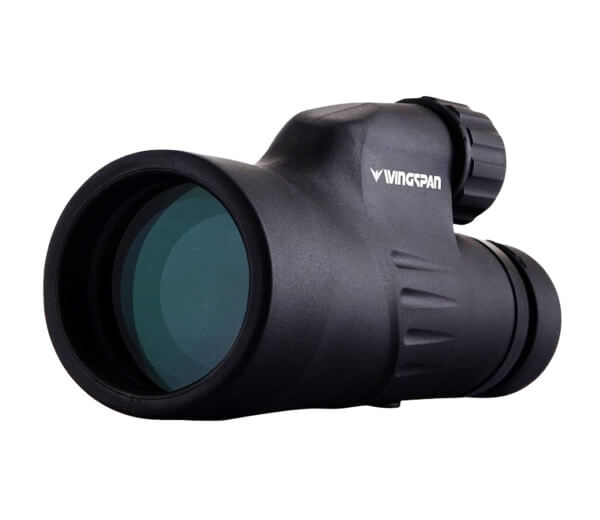
The Wingspan Optics Explorer monocular feels like a premium tool designed for one thing: delivering a crystal-clear image. It claims to offer the brightest and clearest view of any monocular on the market, and our tests show this is not just empty talk.
What We Loved
- Exceptionally sharp and clear image in the center.
- Great one-handed focus design.
- Lightweight and comfortable to hold.
- Durable, non-slip outer coating.
What Could Be Better
- The field of view is not as wide as the Gosky 12×55.
- Does not include a smartphone adapter.
Design and Feel: Made for One-Handed Use
The Explorer has a very smart design. It is covered in a textured rubber armor that provides a secure grip. The shape is ergonomic, fitting nicely in your hand. The single-hand focus system is its standout feature. A large, knurled wheel is positioned perfectly for your thumb, allowing you to focus quickly and accurately with one hand. This is a huge advantage when you are trying to follow a bird or quickly focus on a star.
Optical Performance: Unmatched Center Sharpness
When it comes to pure sharpness in the middle of the view, the Wingspan Explorer was the best of the 12×50 models we tested. Looking at the moon, the edges of craters were defined with stunning clarity. The image was bright and colors were true. We noticed slightly more softening at the very edges of the view compared to the Gosky, but the center was tack-sharp. For looking at specific details on the moon or trying to split a tight double star, this sharpness is a real benefit. The 50mm objective lens gathers a very satisfying amount of light, making star clusters look bright and detailed.
Real-World Use: The Quick-Reaction Monocular
This is the monocular you want for spontaneous sky gazing. Because it’s so easy to hold steady and focus with one hand, you can raise it to your eye and get a sharp view in seconds. It’s also waterproof and fog-proof, so you do not have to worry about a sudden change in weather. While it does have a tripod socket for those who want it, we found it was the most pleasant monocular to use purely handheld for extended periods.
Who Should Buy This Monocular?
Choose the Wingspan Explorer if you value optical clarity above all else and want a monocular that is fast and easy to use without a tripod. It is perfect for the birder who also stargazes and needs quick, sharp views.
Is It Worth the Price?
It is priced competitively. You are paying for superior sharpness and excellent ergonomics. If those are your top priorities, the Explorer delivers great value.
5. The Digital Night Vision Camera: SIONYX Aurora Monocular
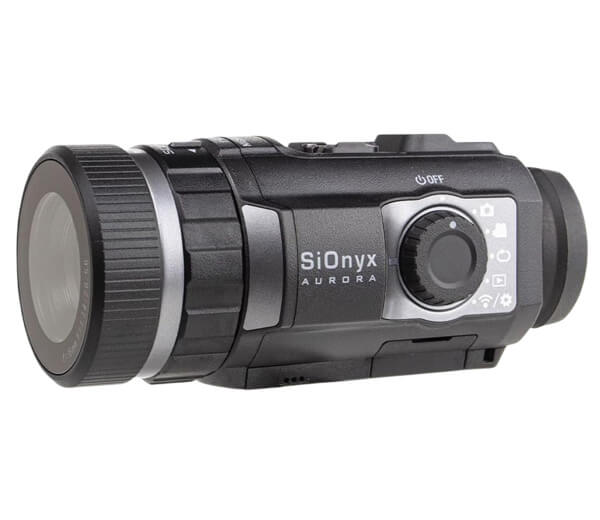
The SIONYX Aurora is a completely different kind of device. It is not an optical monocular; it is a digital camera that lets you see in color in near-total darkness. We tested it to see if it could be used for stargazing.
What We Loved
- Can see and record video in very low light.
- Shows the view on a built-in screen, not through an eyepiece.
- Rugged, waterproof build.
- Comes with a memory card for saving your adventures.
What Could Be Better
- The view is a digital video image, not a direct optical view.
- Screen glow can ruin your night vision.
- Not suitable for viewing faint stars.
Design and Feel: A Small Electronic Box
The SIONYX feels like a tough, compact action camera. It features a compact screen on the back and is designed to withstand tough conditions, meeting military-grade ruggedness standards—even submersible in water. With Wi-Fi connectivity, it streams video directly to your phone, making it both durable and highly functional. This is a thoughtfully crafted piece of tech built to impress.
Optical Performance: A Different Kind of Night Vision
We took the SIONYX out on a moonless night. Its ability to show a color image of the dark landscape was impressive. We could see trees and paths clearly. However, for stargazing, it has major limitations. The digital sensor and lens are not designed to focus on stars. When we pointed it at the sky, the stars appeared as blurry, faint specks. The Pleiades cluster was barely visible as a smudge. The camera’s screen is also very bright, which immediately ruins your eyes’ natural night vision. This makes it hard to look at the screen and then look up at the real sky.
Real-World Use: For Terrain, Not for Stars
The SIONYX is amazing for its intended purpose: seeing in the dark where your eyes cannot. It would be great for night fishing, hiking on a dark trail, or security. But for enjoying the beauty of the night sky, it is not the right tool. The beauty of stars is lost in its digital view.
Who Should Buy This Monocular?
Do not buy the SIONYX for stargazing. Buy it if you need to see and record your surroundings in very dark conditions for safety or fun.
Is It Worth the Price?
As a digital night vision camera, it is a unique product at a fair price. But as a tool for astronomy, it is not a good value.
6. The Premium Daylight Performer: Zeiss 10×25 T Monocular
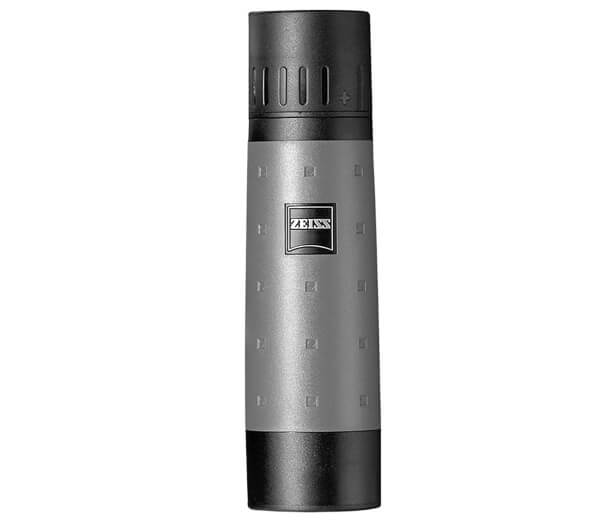
Zeiss is a legendary name in optics, known for making the best camera lenses and binoculars. We had high hopes for their 10×25 monocular.
What We Loved
- Extremely compact and well-made.
- Comes with a nice pouch and cleaning kit.
- The Zeiss name assures quality.
What Could Be Better
- The small 25mm lens is terrible for stargazing.
- Very small exit pupil makes it hard to see in low light.
- Very high price for what it offers.
Design and Feel: A Jewel of Engineering
The Zeiss monocular is beautifully crafted. It is sleek, small enough to fit in a pants pocket, and feels expensive. The lenses have their famous T* anti-reflective coating. For a daytime optic for concerts or sports, the build quality is top-notch.
Optical Performance: Why Size Matters for Stars
We tested the Zeiss on a bright night. The result was deeply disappointing for stargazing. The 25mm objective lens is simply too small to gather enough light from faint stars. The view of the night sky was dark and empty. We could see the moon, but it was small and unimpressive. The “exit pupil” (the small circle of light that hits your eye) is only 2.5mm, which feels like looking through a tiny pinhole in the dark. This makes it very difficult to see anything. In daylight, the image is sharp and bright, but that is not what we were testing for.
Real-World Use: The Wrong Tool for the Job
This monocular is designed for convenience and quality in well-lit situations. It is for a traveler who wants to see a building’s detail or a spectator at a daytime event. Using it for stargazing is like using a sports car to go off-roading; it is built for a different purpose.
Who Should Buy This Monocular?
Only consider the Zeiss if you need the absolute best, most portable monocular for daytime use and price is no object. For stargazing, we cannot recommend it.
Is It Worth the Price?
For stargazing, no, it is not worth the price at all. For its intended daytime use, it is a luxury item for those who want the Zeiss brand.
Check also – Best Night Vision Monoculars Reviews
Side-by-Side Comparison
Now that we have reviewed each model, let’s see how the top contenders directly compare in key areas.
Celestron Outland X 20×50 vs. Gosky 12×55: Power Against Brightness
This is the biggest choice for a stargazer. Do you want high power or a bright, wide view?
| Feature | Celestron Outland X 20×50 | Gosky 12×55 HD |
| Magnification | 20x | 12x |
| Objective Lens | 50mm | 55mm |
| Best for Stargazing | Lunar craters, planetary detail | Star clusters, Milky Way, constellations |
| Tripod Needed? | Absolutely required | Highly recommended |
| Included Tripod? | Yes | No |
| Our Rating | 4.5/5 | 4.3/5 |
The Final Decision:
- Choose the Celestron Outland X if your main goal is to see the moon and planets in as much detail as possible and you don’t mind using a tripod.
- Choose the Gosky 12×55 if you love sweeping views of the starry sky, want the brightest image, and value a lower price.
Which is the Best Truly Handheld Monocular?
For a tool you can use without any support, we compared the Wingspan Explorer 12×50 and the Vortex Solo 10×36.
| Feature | Wingspan Explorer 12×50 | Vortex Solo 10×36 |
| Ease of Holding Steady | Good | Excellent |
| Image Brightness | Very Good | Good |
| Sharpness | Excellent | Very Good |
| Portability | Good (jacket pocket) | Excellent (pants pocket) |
| Durability & Warranty | Good (1-year promise) | Excellent (unlimited lifetime warranty) |
| Our Rating | 4.2/5 | 4.0/5 |
The Final Decision:
- Choose the Wingspan Explorer for the sharper, brighter image in a handheld size.
- Choose the Vortex Solo for ultimate portability, toughness, and the security of a no-fault warranty.
Who Should Buy What Monocular for Stargazing?
To make your choice easy, here are our final recommendations based on what you plan to do.
For the Backyard Astronomer Focused on the Moon
Our Pick: Celestron Outland X 20×50
This monocular, with its tripod, gives you the most detailed lunar views. It is like having a personal telescope without the complexity.
For the Star Cluster and Milky Way Enthusiast
Our Pick: Gosky 12×55 HD
The huge 55mm lens on the Gosky pulls in more light than any other model we tested, making faint star clouds and constellations look brilliant and immersive.
For the Hiker and Birder Who Also Stargazes
Our Pick: Wingspan Optics Explorer 12×50
You need one tool that does it all. The Explorer is sharp for birding, easy to focus with one hand, and powerful enough for great nighttime views.
For the Adventurer Who Needs a Tough, Go-Anywhere Tool
Our Pick: Vortex Optics Solo 10×36
If your monocular will live in your backpack and face rough conditions, the Solo is the one. It is small, nearly indestructible, and has a warranty to prove it.
For the Buyer on a Tight Budget
Our Pick: Gosky 12×55 HD
It offers phenomenal performance for its price. You get a bright, high-quality view without spending a lot of money.
People Also Ask
We answer the most common questions based on our test results.
What is the best magnification for a stargazing monocular?
Our tests show there are two answers. For powerful views of the moon, 20x magnification is best. For wide, beautiful views of constellations that are easier to hold steady, 10x or 12x is the best choice.
Can I use a monocular for stargazing without a tripod?
Yes, but only at lower magnifications. We found that 10x and 12x models can be used handheld if you brace your arms. Any monocular with 15x or 20x magnification, like our top pick, absolutely requires a tripod to be useful.
Why does the front lens size matter so much?
The front (objective) lens is a light bucket. A bigger lens, like a 50mm, collects much more light from faint stars than a small 25mm lens. This is the most important factor for how bright and detailed your view of the night sky will be.
Is a monocular better than binoculars for stargazing?
It is a trade-off. Binoculars can be more comfortable for long sessions. But a good monocular is lighter, more portable, and often costs less than a similar-quality pair of binoculars. For a simple, portable tool, a monocular is an excellent choice.
Our Overall Winner for Most Users
After all our testing, under real night sky conditions, one monocular stands out as the best for most people looking to explore the cosmos.
The Celestron – Outland X 20×50 is our top recommendation.
It wins because it does something the others cannot: it brings the moon thrillingly close, revealing a landscape of craters and valleys. It is the only model that feels like a dedicated astronomy tool. While it requires the included tripod, this is a small price to pay for the incredible detail it provides. It is a complete kit that is ready to use right out of the box.
No matter which monocular you choose from our list, you are getting a tool tested and approved for real stargazing. Forget the hype and focus on what you want to see. Your perfect window to the stars is waiting.
